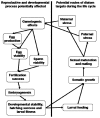The influence of bioactive oxylipins from marine diatoms on invertebrate reproduction and development
- PMID: 19841721
- PMCID: PMC2763107
- DOI: 10.3390/md7030367
The influence of bioactive oxylipins from marine diatoms on invertebrate reproduction and development
Abstract
Diatoms are one of the main primary producers in aquatic ecosystems and occupy a vital link in the transfer of photosynthetically-fixed carbon through aquatic food webs. Diatoms produce an array of biologically-active metabolites, many of which have been attributed as a form of chemical defence and may offer potential as candidate marine drugs. Of considerable interest are molecules belonging to the oxylipin family which are broadly disruptive to reproductive and developmental processes. The range of reproductive impacts includes; oocyte maturation; sperm motility; fertilization; embryogenesis and larval competence. Much of the observed bioactivity may be ascribed to disruption of intracellular calcium signalling, induction of cytoskeletal instability and promotion of apoptotic pathways. From an ecological perspective, the primary interest in diatom-oxylipins is in relation to the potential impact on energy flow in planktonic systems whereby the reproductive success of copepods (the main grazers of diatoms) is compromised. Much data exists providing evidence for and against diatom reproductive effects; however detailed knowledge of the physiological and molecular processes involved remains poor. This paper provides a review of the current state of knowledge of the mechanistic impacts of diatom-oxylipins on marine invertebrate reproduction and development.
Keywords: apoptosis; developmental stability; polyunsaturated aldehydes; reproductive toxicity; teratogen.
Figures








References
-
- Legendre L. The significance of microalgal blooms for fisheries and for the export of particulate organic carbon in oceans. J Plankton Res. 1990;12:681–699.
-
- Mann KH. Physical oceanography, food chains, and fish stocks: A review. ICES J Mar Sci. 1993;50:105–119.
-
- Hamm CE, Merkel R, Springer O, Jurkojc P, Maier C, Prechtel K, Smetacek V. Architecture and material properties of diatom shells provide effective mechanical protection. Nature. 2003;421:841–843. - PubMed
-
- Miralto A, Barone G, Romano G, Poulet SA, Ianora A, Russo GL, Buttino I, Mazzarella G, Laabir M, Cabrini M, Giacobbe MG. The insidious effect of diatoms on copepod reproduction. Nature. 1999;402:173–176.
-
- Ianora A, Miralto A, Poulet SA, Carotenuto Y, Buttino I, Romano G, Casotti R, Pohnert G, Wichard T, Colucci-D’Amato L, Terrazzano G, Smetacek V. Aldehyde suppression of copepod recruitment in blooms of a ubiquitous planktonic diatom. Nature. 2004;429:103–407. - PubMed
Publication types
MeSH terms
Substances
LinkOut - more resources
Full Text Sources
